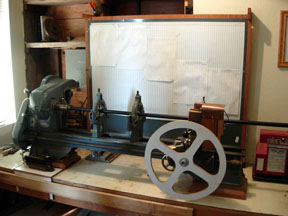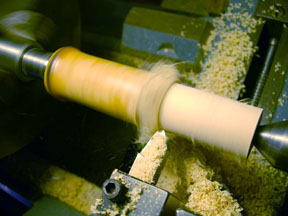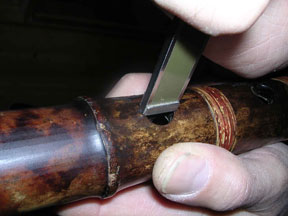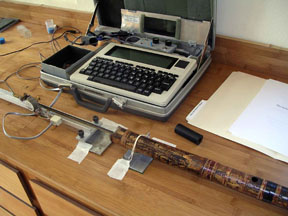|
|
Monty H. Levenson STALKING
THE WILD BORE:
|
|
|
Monty H. Levenson STALKING
THE WILD BORE:
|
About twenty years after making my first shakuhachi 1970, I succeeded in developing the Precision Cast Bore technology. This unique innovation allowed me to fabricate the interior of a shakuhachi to extremely fine tolerances based on analysis of some if the finest historical and modern instruments available in Japan. The process, however, was achieved empirically, using the old reliable (and very American) "seat-of-the-pants" approach based on trial-and-error. (Mostly the latter, I must admit.) After making a large number of flutes using this technique, I decided it wasn't enough to make a decent instrument without fully understanding how its sound mechanics and acoustics worked . Easier said than done with an instrument they say "takes 3 years to learn how to shake your head" in order to achieve the proper nuance of tone.
Starting out with my daughter's high school physics textbook, I went on to study the latest research in acoustical physics of woodwind instruments. Reading as much of the literature as possible, conferring with professional flute makers and players in Japan and around the world, and analyzing a wide variety of historical and modern shakuhachi, I began to develop a sense of how this remarkable instrument is able to transform the energy of breath into sound. Much has been written about woodwind acoustics, but very little about how it relates to the traditional Japanese bamboo flute. This treatise explores the seminal issues and divergent views surrounding the hotly contested question of how the shakuhachi actually works. Not intending to present the final word on the matter, I have relied upon my personal experience as a maker to frame the debate governing tone production and provide an overview bringing different perspectives of traditional and modernist views to the table.
Chapters include a discussion of changes in the shakuhachi's structure and design over hundreds of years using Darwin's theory of natural selection, rather than from myth and legend, to understand how the instrument evolved. Tracing the modifications in form over time leads to a query on the future of bamboo. Indeed, is there one?
Much of the study focuses on the interior bore of the shakuhachi and its influence on acoustical and performance qualities of the instrument. Pitch, timbre, resonance and the harmonic configuration of sound are all discussed in an effort to understand how tone production operates. What contributes most to shaping the unique sound of the shakuhachi, the material it is made from or the resonating air column inside the bore? Opposing viewpoints advocated by traditionalists and scientists are presented, juxtaposed and critically compared.
Finally, some new technologies and strategies for shakuhachi making I have come up with in the last few years are featured in a photo review. These include a computer interface designed to measure precision bore profiles, a laser tracking lathe, new tools and techniques for turning bamboo and a shakuhachi headjoint for the silver flute.
32 pages. CM-31
Please note: "Stalking the Wild Bore" originally appeared in the Annals of the International Shakuhachi Society - Vol. 2.
 |
 |
 |
 |
Monty H. Levenson was born and raised in Williamsburgh, Brooklyn, NY. He lives and works at his rural homestead located in the hills of Mendocino County, California. He also maintains a shakuhachi workshop in the village of Kitagawa, Tokushima Prefecture, Shikoku Island, Japan.
|
Learn more about making shakuhachi flutes: Elmer Takeo Kudo, KINKO
SHAKUHACHI: One Maker's Approach |
| Price of Book | Ordering Information |